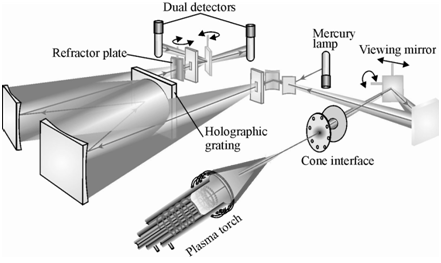Sequential Spectrometers:
These instruments use a moveable grating monochromator to select wavelengths in sequential order and use a single photomultiplier tube to detect them. The grating of the monochromator is of holographic type having a large number of grooves. The monochromator is programmed to make measurements in turn or sequentially at a pre- programmed series of peaks and background wavelengths to cover the elements of interest.

Figure: A schematic diagram showing the optical diagram of a sequential ICP optical emission spectrometer
For this purpose, the grating of the monochromator is rotated in a controlled manner so as to sequentially focus a predetermined wavelength on the exit slit. Alternatively, the grating is kept fixed and the slit and the photomultiplier detector are moved to detect the desired wavelengths. As just a few elements are used these instruments are economical.
A schematic diagram of a sequential spectrometer is shown in Figure. However, poorer accuracy, longer analysis times and precision are the main drawback of sequential instruments. Further to these, the reproducibility of wavelength selection is another area of concern. For partly overcome a problem of longer analysis times slew scan instruments have been developed. In these instruments the monochromator or the detector and slit combination are moved in such a way that they quickly reach on to a wavelength of interest for a given analyte and then slowly scan around it in small steps. Unneeded to say, this could be achieved just with the help of an electronic control by a suitable computer.